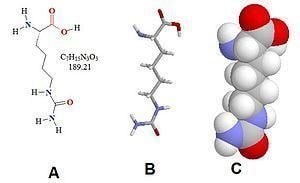Formula C7H15N3O3 | Molar mass 189.2123 g/mol | |
 | ||
Homocitrulline top 13 facts
-Homocitrulline is an amino acid and a metabolite of ornithine in human metabolism and mammalian. The amino acid can be detected in larger amounts in the urine of individuals with urea cycle disorders. At presence, it is thought that the depletion of the ornithine supply causes the accumulation of carbamyl-phosphate in the urea cycle which may be responsible for the enhanced synthesis of homocitrulline and homoarginine. Both amino acids can be detected in urine. Amino acid analysis allows for the quantitative analysis of these amino acid metabolites in biological fluids such as urine or blood.
Contents
Description
Homocitrulline is one methylene group longer than citrulline, but similar in structure. The metabolite is generated from a lysine residue after lysine reacts with cyanate. Cyanate is present in the human body in equilibrium with urea. Under physiological conditions the urea concentration may be too low to allow extensive carbamylation. However, the conversion process leading to the formation of homocitrulline from lysine in proteins is known to occur in vivo. During renal failure conditions, the urea concentration increases and carbamylation of many proteins can occur, which can be detected. It is believed that most carbamylation takes place during inflammation when the enzyme myeloperoxidase is released from neutrophils. This enzyme converts thiocyanate to cyanate. Increased levels of cyanate can now carbamylate lysine residues.
Myeloperoxidase released from neutrophils converts thiocyanate to cyanate which carbamylates lysine residues to form homocitrulline. Thiocyanate (SCN−) is a naturally occurring pseudohalide found in dietary sources. Myeloperoxidase can use SCN− as a cosubstrate together with hydrogen peroxide (H2O2) to form cyanate. In patients with kidney dysfunction urea is elevated. Urea is in equilibrium with cyanate and isocyanate. Carbamylation of nucleophilic amino groups, for example lysine residues, can modify protein structures and ultimately cause metabolic dysfunctions.
Homocitrulline in diseases
Homocitrulline has been suggested as a confounding antigen for rheumatoid arthritis antibodies targeting citrullinated proteins/peptides. Antibodies binding to homocitrulline-containing sequences have been found in rheumatoid arthritis patients' sera More recently, it has been shown that homocitrulline-containing proteins are present in rheumatoid arthritis (RA) joints. In rodents they may affect T-cell triggering and possibly autoantibody formation, and possibly also in humans.
In another metabolic disorder, in the hyperornithinemia-hyperammonemia-homocitrullinuria (HHH) syndrome, first described in 1969, ornithine levels maybe elevated five to ten times in comparison to normal levels. In addition, in this syndrome, levels of alanine, orotic acid and homocitrulline may be elevated as well. In people with hyperammonemia orotic acid and homocitrulline appear to be chronically elevated after a high protein diet, but may be normal when fasting.
The metabolic disorder, lysinuric protein intolerance is caused by the body's inability to digest and use certain protein building blocks or amino acids. These are lysine, arginine, and ornithine. These amino acids are found in many protein-rich foods. Since in this disorder the human body cannot effectively break down these amino acids people typically experience nausea and vomiting after ingesting protein rich foods. Associated features of this protein intolerance may include an enlarged liver and spleen, short stature, muscle weakness, impaired immune function, and progressively brittle bones that are prone to fracture and a lung disorder called pulmonary alveolar proteinosis may also develop. In addition, the accumulation of amino acids in the kidneys can cause end-stage renal disease (ESRD). In ESRD the kidneys are no longer able to filter fluids and waste products from the body effectively.
